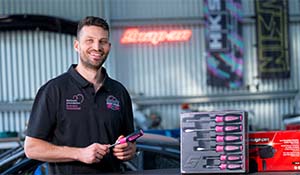Porsche builds new “No.1”
The actual 356 ‘No.1’ is still in Porsche’s possession, but was subject to a number of repairs, modifications, mechanical and body changes in its early history (including one owner who rearranged the PORSCHE bonnet letters to spell PESCO!), to the point where Porsche decided it could no longer be restored to its original appearance and specification.
Then and Now. Porsche records show that tinsmith Friedrich Weber spent two months hand-beating the aluminium body that would adorn the tubular space-frame chassis of the first Porsche. That body was different from the generally-accepted notion of a 356 shape, with a squarer front end and more tapered rear. The engine cover was different, too, consisting of a one-piece lid that hinged at the rear and extended all the way to the passenger compartment. This was altered to a two-piece cover on the original roadster and subsequent models.
To recreate the 356 body as it was built in 1948, Porsche started by 3D scanning the existing No.1, then superimposed this data onto scans of original design and engineering drawings. Porsche Archive staff members also consulted all the photos of the original 356 they could get their hands on, as well as period journals and drawings. With all this data, an accurate recreation of the body that Weber had hand-formed all those years ago was milled from a block of rigid foam, which then served as the buck to make new panels, assisted by old-style wooden gauges.
In order to reproduce the first colour (of many) that the first 356 wore, period photography was no help, as it was in black and white, so Porsche staff scoured the original car’s body and found a trace of pale blue – agreed to be the original colour – in a section under the dash. Samples of this paint were taken and analysed in order to reproduce the original colour as closely as possible. A similar attention to detail and commitment to authenticity was used in recreating the badging, interior trim, instrumentation and other fittings, which thanks to modern technologies like 3D-printing are much easier to recreate today than they were even a few years ago. Earlier this year, Porsche revealed they were using 3D-printing and other “additive” manufacturing processes to reproduce selected parts – from trim pieces to sturdier engineering componentry - for classic models in their range.

Show Tour. Combining modern scanning technology with old-fashioned hand skills and craftsmanship, Porsche completed their recreation of No.1 in May after eight months’ work. Following an unveiling at the Porsche Museum on 8 June, the No.1 recreation and the original car will both be sent on a worldwide tour, including stops at the Goodwood Festival of Speed, Porsche Rennsport reunion in the USA and other events in Europe, South Africa and China.
Curiously, despite the attention to detail in accurately replicating things like the body, paint colour and even the weave of the floor mats, the modern No.1 was created purely as a show car. There’s no drivetrain and only a pipe for a rear axle, but the front end retains a Volkswagen-sourced steering column, box and front axle, just like the original 356.














